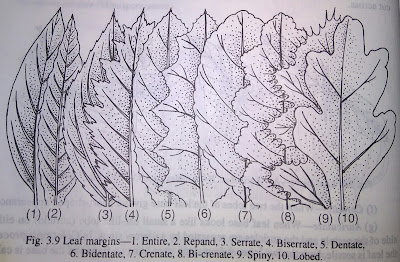The leaf
Types Of Leaf base: The base of
leaf is usually the end of attachment.Different types of leaf bases are found which are discussed below: -
 |
| Leaf bases |
(a) Attenuate-When the lower sides constricting concavely and into wing-like petiole.
(b) Cuneate-When leaf base becomes narrow to broad wedge-like taper, acute and the sides become straight.
(c) Oblique-When the lowermost sides of the leaf base become unequal.
(d) Obtuse-When the leaf base is round and constricting abruptly to the petiole,
(e) Truncate-Here the leaf base with a nearly straight line across the bottom, as if cut across.
(f) Cordate-When the two lobes of the leaf base gives a heart-shaped appearance. ‘
(g) Auriculate-When leaf base looks like a small ear-like lobe (auricle) on either side of the petiole and the auricles are separated by a narrow sinus. In Calotropis procera, the leaf is sessile, here the two lobes surround the stem like two flaps and the base is called auriculate.
(h) AmplexicauI-This term is often used when the auriculate leaf base completely Clasps the stem.
(i) Perfoliate-When the basal lobes of the leaf lamina fuse together after completely clasping the stem as if the stem has pierced the leaf e.g. Bupleurum.
(j) Connate-When the basal lobes of the two opposite leaves fuse together after completely clasping together and looks like one leaf, the stem passing through the centre of leaf, e.g. Canscora.
(k) Sagittate-When a pair of basal lobes turned downwards and inwards, their apices being acute or obtuse.
(l) Hastate-When a pair of basal lobes are deeply incised and the lobes are flaring outward.
 |
| Leaf margins |
Read also-
Leaf: Definition, parts of typical leaf and kinds of leaves-digieduco
Leaf margins-The shape of the margin of leaf lamina or leaf blade is dependent on the extent to which the leaf blades are subject to varieties of incisions, cuts or irregularities or completely free from them. The following types of leaf margin are recognised :
l. Entire or Even-In this type, the leaf margin is even and smooth, e.g. Mangifera sp. (Anacardiaceae), Artocarpus sp. (Moraceae), Musa sp. (Musaceae), Ficus sp. (Moraceae), Anona reticulata (Anonaceae) etc.
2. Repand or Undulate-When the leaf margin is undulating or wavy ; e.g. Polyalthia longifolia (Anonaceae), Mimusops elengii (Sapotaceae) etc.
3. Serrate-When the margin of lamina is incised like the teeth of a saw, e.g. Hibiscus rosa-sinensis (Malvaceae), Azadirachta indica (Meliaceae), Rosa sp. (Rosaceae) etc.
4. Serrulate-A margin representing the diminutive of serrate, finely serrate, e.g. Symplocos ramsissima (Symplocaceae), Trema orientalis (Ulmaceae).
5. Double serrate-Small and large teeth are alternating with each other, e.g. Sida acuta (Malvaceae).
6. Dentate-When the teeth of the leaf lamina are sharp and projected outwards
almost at right angles to the margin, e.g. Nymphaea esculenta (Nymphaeaeeae).
7. Crenate-When the margin is toothed but the teeth are rounded e.g. , Centella asiatica (Umbelliferae), Kalanchoe binnata (Crassulaceae).
8. Spiny--Margin of the leaf blade with large teeth-like projections ending in spines, e.g. Argemone mexicana (Papaveraceae).
9. Bi-sérrate-When the margin is toothed but the teeth are again serrated e.g. Ulmus campestris (Ulmaceae). ‘
10. Bi-dentate-When the margin is toothed and the teeth are again dentate. Examples : Castanopsis indica, Quercus dentata (Fagaceae) etc.
11. Bi-crenate-The margin is toothed and the large rounded teeth are again crenate on their margin.
12. Lobed-When the maxgins of the blades are more deeply divided than in the above instances, the divisions are then generally called lobes and the margins of the leaf blade lobed 0r incised, e.g. species of Papaver (Papaveraceae), Chrysanthemum (Compositae) etc.
Covering or Vestiture of Leaf Surface : The leaf surface comprises both the upper i.e. dorsal as well as the lower i.e. ventral surfaces of the entire blade. The leaf surface is provided with coverings or vestitures ; those vestitures may be very smooth, shining, rough to touch or may be provided with various emergences e.g. soft hairs, stiff bristly hairs, spines and prickles etc. The following terms are used to describe the vestitures of leaf surfaces :
(a) Glabrous-The surface is smooth due to complete absence of any emergences like hairs or any other outgrowths, e.g. Mangifera indica (Anacardiaceae), Syzygium jambos (Myrtaceae), Artocarpus hetemphyllus (Moraceae) etc.
(b) Glaucus-The surface is covered with waxy coating causing a shiny, either whitish or bluish tinge, e.g. Calotropis sp. (Asclepiadaceae), Nymphaea sp. (Nymphaeaceae) etc.
(c) Glutinous or viscose-When the surface is covered with a sticky exudation, e.g_ Nicotiana tabacum (Solanaceae), Cleome viscosa (Capparidaceae) etc.
(d) Scabrous-The surface is rough to touch due to the presence of short rigid points, e.g. Ficus cunia (Moraceae).
(e) Spinose or Spinous-The surface is covered by spine-like prickles, e.g. Solanum ferox, Solanum xanthocarpum (Solanaceae) etc.
(f)Rugose-The surface is provided with small folds and shallow depressions, e.g, Rubus rugosus (Rosaceae).
(g) Pubescent or Hairy-When the surface is covered with various types of hairs or hairy outgrowths. The presence of the difference in texture, structure and arrangement of such hairs determines the terminology. Therefore hairy leaves are of the following types:
 |
| Leaf surface |
(i) Puberulous-When the leaves are covered with very small, short fine and straight hairs at right angles to the surface.
(ii) Wooly-Covered with dense, long, soft entangled and curled hairs.
(iii) Villous-When covered with more or less erect, dense, long and soft hairs.
(iv) Pilose-Covered with very long, rather straight and soft hairs.
(v) Tomentose-When covered with felted woolly hairs, generally curled and adpressed to the surface.
(vi) Velutinous-When covered with velvety, pile-like, erect, straight dense hairs much longer than puberulous.
(vii) Scabrous-When covered with scattered harsh hairs with bulbous bases.
(viii) Hispid-Covered with bristly, dense, erect, straight and stiff hairs.
(ix) Hirsute-When covered with short erect stiff (but not harsh) hairs.
(x) Strigose-Covered with bristle-like harsh, straight, soft and stiff hairs.
Read also-



Comments
Post a Comment